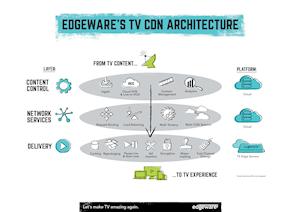4K is Perfect for Internet TV—Here’s Why

By Richard Brandon CMO at Edgeware

The advent of 4K has been talked about and talked about in the media world. Well, guess what? It’s here. The discussion has shifted from theory and conjecture to real needs and challenges. Consumers have demonstrated the appetite for it. Now broadcasters, service providers, content owners and content creators must deliver it.
There are enough challenges—from bandwidth strains to quality concerns—when delivering 4K content for broadcast TV. And when you consider 4K for internet-delivered channels it seems even more daunting. But it doesn’t have to be. Here’s what you need to know.
Build or Buy?
More pixels mean more detail and 4K has four times the pixel density of HD. And as providers we better get proficient with 4K because 8K and virtual reality are nipping at the heels of Ultra HD. And with those resolutions will come even greater challenges.
For those who want to deliver 4K content over non-broadcast channels, there are essentially two choices: buy/lease as a service or build your own content delivery network. In either case, the core issue is how to deliver high-quality TV services over networks not originally designed for huge volumes of video. While traditional CDNs seek to alleviate these challenges, they fall short. With general-purpose CDNs costs rise in direct proportion to the capacity used, so they don’t offer efficient economy of scale.
They also can’t effectively scale in the way required for broad-reach content delivery. And bit-laden, bandwidth-sucking 4K brings even greater challenges.
TV CDNs
The purpose-built TV CDN is designed specifically to address these issues. At Edgeware, a three-layer architecture is optimized for TV services at every layer. This allows each function to scale in the most optimal way – from content management that must support large volumes of TV assets to personalized TV streaming that needs to scale to huge numbers of viewers. Software functions manage content and network services while a hardware-accelerated delivery layer guarantees the performance of personalized streams to individual viewers. The result? TV servers aren't limited by general-purpose computing architectures that suffer from common CPU bottlenecks between storage and delivery. And the platform provides complete flexibility to deliver any mix of TV services - whether they're over IPTV or WebTV.
Rising bits and expectations
The three most significant challenges to non-broadcast TV, especially when delivering 4K content, are: quality, scalability and cost. While each is critical in a different way, they’re all interdependent.
Quality
Buffering, delays, glitches. No doubt we’ve all experienced these annoyances while consuming content. And there’s also little doubt we’ve also been frustrated enough to turn away from that content when quality slips. It’s tough to regain viewers with negative experiences. And the greatest TV in the world is meaningless if it doesn’t offer a high-quality, immersive viewing experience.
Scaling
Scalability is absolutely key in today’s increasingly IP-enabled TV audiences. Anyone delivering content to users must cope with increasing demand. Netflix for example has implemented a dedicated and optimized delivery network and maintains the distribution of high-quality content to nearly 50 million users. And providers need to scale for viewing peaks that occur with high-profile live events like the Olympic Games, Super Bowls and Academy Awards ceremonies.
Cost
The ability to scale brings cost-saving efficiencies. And with a TV CDN you pay for it once, that’s it. A purpose-built system can also be designed specific to individual needs. Best of all, you don’t have to make the leap all at once. You can migrate to a TV CDN one layer at a time as it makes sense for your business.
A TV CDN also offers control over your own network and valuable insight in the form of analytics into your viewers.
Who’s doing it now?
Netflix, Amazon and others are racing to offer more 4K programming. As of November 2016, you can binge watch The Gilmore Girls in 4K via Netflix. Who knew? And while 4K over non-broadcast channels may still be in its infancy, it’s growing – fast. This year PCCW and TVB in Hong Kong implemented their own purpose-built TV CDN to deliver high-quality 4K content, control bandwidth and gain insight into their viewers. As you read this, more broadcasters and OTT providers are doing the same.
What’s next? Live sports and beyond
We’ve taken the first step. Consumers can watch what they want, when they want, wherever they want it. Now we’re starting to see a level of reality that’s coming closer and closer to real life. 4K is an obvious example. We’re seeing OTT operators increasingly launching services in 4K. The BBC, for example, is launching 4K on its iplayer before debuting it on broadcast TV. As always there’s an economic incentive: it’s easier (read: less costly). It’s not taking up more spectrum - just more bits.
Live sports is an area rapidly embracing 4K, both in the US and abroad. It’s the next evolution of bringing viewers closer, immersing them more in content, and viewers are game. Get ready for the 4K content explosion over your computer, your cell phone or your tablet. It’s coming. And with the help of TV CDNs, you won’t want to turn away.
About Edgeware
Edgeware builds hardware and software systems that deliver TV content over IP networks. Our unique technology delivers TV at huge scale, gives a unique insight into viewing behavior and delivers TV with an outstanding viewing experience.





